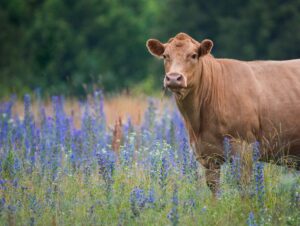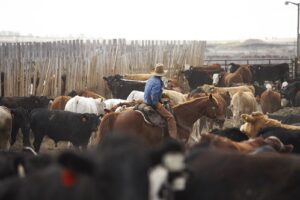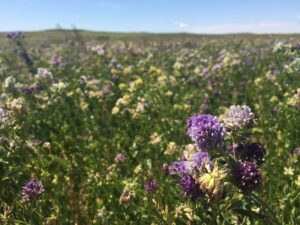Improving Environmental Performance and Bottom Lines
Remarque : cette page web n’est actuellement disponible qu’en anglais.

On Earth Day, Canadians and people all over the world celebrate the positive impacts they can have on the environment. In the past, the Beef Cattle Research Council has highlighted beef’s positive impact on biodiversity, carbon sequestration and maintaining prairie habitat, as well as positive changes producers have made to reduce the environmental footprint of Canadian beef. What often gets overlooked is that everyday improvements in efficiencies help to reduce the environmental impact of Canadian beef. This means that simply by working to improve their bottom line, beef producers are improving the environmental performance of our industry at the same time.
Improving production efficiencies, greater forage productivity, enhanced reproductive performance, improved animal health and reduced days on feed all play a role in reducing the impact that beef production has on the environment.
The following are some current projects underway, funded by the Canadian Beef Check-Off, that are working to improve beef production efficiencies and consequently reduce the environmental impact of beef.

Understanding Feedlot Lameness:
Feedlot lameness is a common problem with both economic and animal welfare implications. Animals that are lame often end up on feed longer and some end up being euthanized. Dr. Karen Schwartzkopf -Genswein and Dr. Murray Jelinski and their team have been looking into ways to better understand and treat feedlot lameness. In this project they are looking specifically at cases of digital dermatitis and toe tip necrosis and comparing different antibiotic and non-antibiotic treatment methods. This work will help determine which treatment methods are most effective and will reduce the reliance on antimicrobials, reduce the risk of antimicrobial resistance , improve animal welfare, and improve production efficiencies leading to a reduced environmental footprint.
Improving Grazing in Forested Areas:
Forested areas are important grazing for many beef producers in regions across the country, but often, as the trees age, they begin to block out sunlight meaning growing high quality forages for grazing is difficult. For this project Dr. Lauchlan Fraser and his team paired up with the logging industry to try to find a solution to this problem that will benefit both industries. Researchers are looking at a silvopasture system where trees are thinned in strips of varying widths to determine what works best to optimize both forage and timber growth. Integrating strip logging and grazing into a forestry system has the added benefits of increasing biodiversity, helping reduce erosion, provide forest fire management and promoting faster habitat recovery for logged sites.

Learning from Good Feedlot Pen Checkers:
Bovine respiratory disease (BRD) is a major cause of sickness, death, and production losses in the feedlot industry. One of the most important factors in treatment success is early detection and treatment. This may sound easy but the signs are often subtle and hard to distinguish in a pen of cattle. Good pen checkers are able to identify and pull cattle that are sick early, have lower rates of “false pulls” and have lower re-treatment rates. Although lots of research has been conducted on BRD treatment, there is little work focusing on what top performing pen checkers are looking for that enables them to make better and earlier diagnosis. Dr. Diego Moya, and his team are doing just that. They will visually evaluate and interview experienced pen checkers to learn how they decide which animals to pull. They will identify commonalities among effective pen checkers and use these common habits and cues to develop resources for inexperienced or less successful pen checkers. From there they will test those recommendations; if they prove successful, they will develop training tools for detecting BRD signs early. Enabling more people to detect BRD early will improve treatment rates and reduce the amount of time animals are sick and off feed, as well as reduce the number of deaths from BRD. Improving animal health and growth efficiency reduces feed inputs and greenhouse gas (GHG) emissions per kilogram of beef produced.

Adding a legume to forage stands increases forage yields and allows producers to raise more cattle (and pounds of beef) on less land. Alfalfa, although widely used, is susceptible to many stressors including salinity, drought, and winterkill. These factors can result in alfalfa declining in a mixed forage stand over time. Dr. Stacy Singer and her team are working to breed an alfalfa plant that is more resilient to these and other stressors. They are using modern genome editing technologies that enable them to tweak genes that are already present in the plant. This project will design plants that survive and flourish in harsh environments, helping producers to keep alfalfa in their forage stands longer and reduce reseeding costs and environmental impacts.
These projects, and many others funded by producer check-off dollars, help make small steps toward a more efficient and environmentally friendly beef herd. On their own, each project may seem to make a slight contribution, but minor, cumulative advancements have led to significant improvements in beef’s environmental performance in the big picture. For example, between 1981 and 2011, greenhouse gas emissions per kilogram of Canadian beef dropped by 15%, and water use per kilogram of Canadian beef fell by 17%. These are advancements worth recognizing and celebrating.
Click here to subscribe to the BCRC Blog and receive email notifications when new content is posted.
The sharing or reprinting of BCRC Blog articles is welcome and encouraged. Please provide acknowledgement to the Beef Cattle Research Council, list the website address, www.BeefResearch.ca, and let us know you chose to share the article by emailing us at info@beefresearch.ca.
We welcome your questions, comments and suggestions. Contact us directly or generate public discussion by posting your thoughts below.